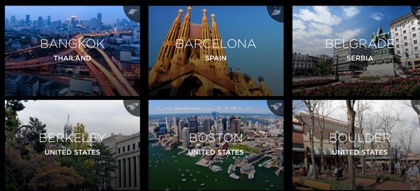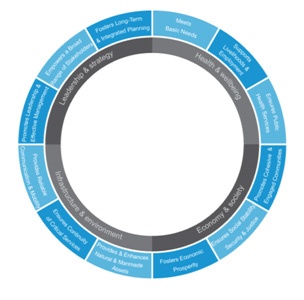Climate adaptation is just one piece in the complicated resilience puzzle that cities face, and it’s directly and indirectly related to a host of challenges from flooding to infrastructure to public health. Resilience touches many city departments and budgets and outside stakeholders.
So how is a city to address resilience in a proactive and comprehensive manner?
The Rockefeller Foundation is seeking to address that question with a nonprofit they seeded called 100 Resilient Cities, the crux of which is an application-based selection of the 100 cities that they will support directly to “build resilience to the economic, social and physical challenges we face in the 21st century.
The 60+ cities selected to participate so far (the final group will be announced in 2016) include the big names you would expect like Boston, London, San Francisco and Sydney. But the list also includes Belgrade, Serbia; El Paso, Texas; Durban, South Africa; Norfolk, Virginia; Quito, Ecuador; and Toyama, Japan.
In other words, a very diverse – in geography, demographics, and resilience challenges – group. Still, it’s a small group. And many of us aren’t in it.
But the beauty of 100 Resilient Cities is that you don’t have to be a participating city to benefit from the vast resources being poured into this effort.
Here are 5 of the top resources from 100 Resilient Cities that all other cities can use:
1. Search by City and their Common Challenges
Choose one of the 100 cities on their website and you’ll see the specific resilient challenges they face, an overview of what they are doing, links to recent stories about the city, and a snapshot of that city. Plus, once you’re in a city’s profile you can hone in on a particular resilience challenge and find all the cities dealing with the same thing.

Click on Boston and you’ll see that their resiliency challenges include: flooding, infrastructure failure, lack of affordable housing, rising sea level and coastal erosion, social inequity and terrorism. (That list also serves as a good reminder to us that “resilience” extends far beyond climate change impacts) You can “Meet the Chief Resilience Officer” and find cities from Texas to India facing similar resilience challenges.
2. Deep Dives on Important Issues from Experts and Leading Cities
Maybe you don’t have the budget to travel to global meetings, but that doesn’t mean you can’t learn from those who attend and present through their participation in 100 Resilient Cities.
Take, for example, the “Rotterdam Exchange: Water Management and Multi-Benefit Solutions Handbook.” First, it’s not a random or obscure topic. They note that “of the more than 1000 applications received for membership in the 100 Resilient Cities network to date, 60% identified flooding as one of the top shocks they face, while 20% identified water shortage as their top stress.” Second, it’s far more than an agenda from the event with a bunch of out-of-context PowerPoints. Here’s how they describe it:
In October 2015, the Chief Resilience Officers (CROs) and resilience team members of Bangkok (Thailand), Berkeley (USA), Mexico City (Mexico), New Orleans (USA), Norfolk (USA), Rome (Italy), Rotterdam (Netherlands), Surat (India), and Vejle (Denmark) convened in Rotterdam to share lessons learned and innovative approaches to water management, identify opportunities for collaboration, and learn from the living laboratory that is Rotterdam.
The “Rotterdam Exchange: Water Management & Multi-Benefit Solutions Handbook” highlights the learnings from this three-day Exchange and features tactical solutions and tools from both participating 100RC member cities and 100RC Platform partners.
The collective hope of Exchange participants is that Chief Resilience Officers from around the world, their team members, and other resilience practitioners will look to these lessons and tactics when confronting water management challenges in their cities.
So you didn’t need an invitation, budget or passport to download the handbook and start learning and doing.
3. City Resilience Framework
Perhaps what is most appealing about 100 Resilient Cities to participating and nonparticipating cities alike is the brainpower dedicated to the endeavor. A lot of us simply don’t have the time (and maybe not the expertise) to do the research, create the tools, and tap the network that would help us get up to speed – or bring decision makers and stakeholders up to speed. But they’ve got top experts churning out resources that are specifically designed to be shared far and wide.
The City Resilience Framework is a perfect example.

They describe it as providing “a lens to understand the complexity of cities and the drivers that contribute to their resilience, and a common language that enables cities to share knowledge and experiences.”
It is built on four dimensions of urban resilience:
• Health and Wellbeing
• Economy and Society
• Infrastructure and Environment
• Leadership and Strategy
And each dimension includes 3 “drivers” that are actions cities can take to improve their resilience. For example, the “Infrastructure and Environment” dimension includes these drivers:
• Provide and Enhance Protective Nature and Man-Made Assets
• Ensure Continuity of Critical Services
• Provide Reliable Communication Mobility
Don’t roll your eyes and think this is a wonky 30-page white paper. They provide it in an interactive online version as well as an easy-to-print pdf.
4. Learn about Chief Resilience Officers
If your city is considering hiring – or seeking a funding source to hire – a Chief Resilience Officer or similar position, this blog post
is a great overview of what this person can accomplish for a city’s resiliency goals. They describe the position as “instrumental to how 100 Resilient Cities is helping cities address the challenges of complexity and scalability, and thus how they will contribute to the evolution of a long-lasting global community of practice around urban resilience.”
So maybe if this hadn’t been top of mind or budget priorities, it should be?
5. Access Policy Tools
100 Resilient Cities is a nascent organization in many ways, and resilient cities aren’t created over night or even over a decade. So we expect more and more template resources like the 10% Resilience Pledge in the coming years.
The Pledge – announced at COP21 in Paris and signed by 22 cities and counting – “urges mayors of 100 Resilient Cities to make the most ambitious commitment to city resilience in history, promising 10% of their cities’ annual budgets toward resilience-building goals and projects, without raising additional funds or taxes.”
Bottom line: Sure, 100 Resilient Cities directly serves – with financial assistance, technical support and access to the network and events – just 100 cities.
It’s an elite group. But it’s not exclusive.
The lessons they learn, the resources they are developing, the tools they are creating are designed to share with cities around the world.



